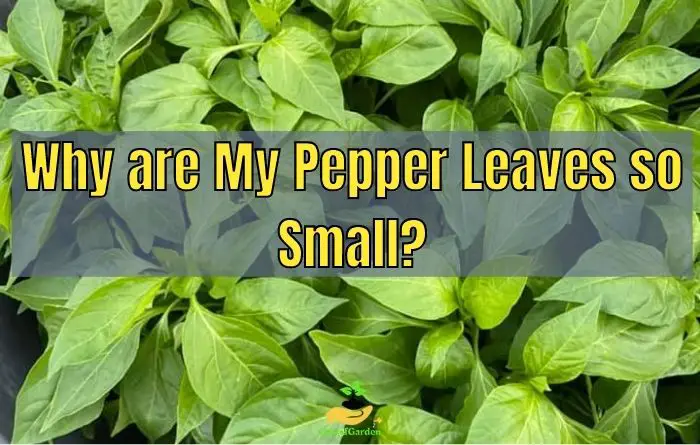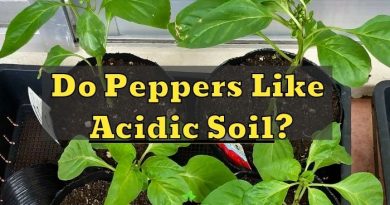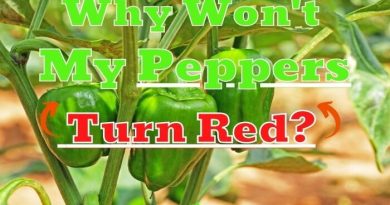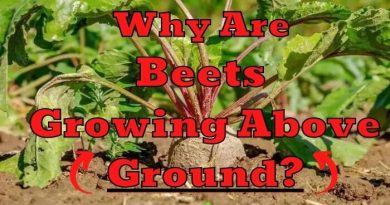Why are My Pepper Leaves so Small? [5 Surprising Reasons]
Are your pepper leaves looking small and stunted? Are you wondering what could be causing this frustrating problem? Look no further! In this post, we’ll explore the various reasons why your pepper leaves may be small, from nutrient deficiencies to extreme temperatures and everything in between.
Pepper leaves remain small due to various factors, including nutrient deficiencies, environmental stressors like insufficient light, extreme temperatures, water stress, poor soil drainage, overcrowding, pests and diseases, and genetic factors. It’s important to identify the underlying cause and implement appropriate treatment options that may include adjusting growing conditions, providing adequate light and water, adjusting soil pH, removing pests and diseases, and using proper pruning techniques.
Causes of Small Leaves in Pepper Plants
1.Genetics and Pepper Variety
The genetics of the pepper variety you are growing play a significant role in determining the size of your pepper leaves. Different pepper varieties naturally exhibit variations in leaf size and shape.
Some varieties naturally have smaller leaves, while others have larger foliage. Therefore, it is essential to choose pepper varieties that are known for their larger leaf size if that is your preference.
| Peppers with Small Leaves | Leaf Description |
|---|---|
| Thai Hot | Small, narrow leaves with a pointed shape |
| Chiltepin | Tiny, compact leaves |
| Tabasco | Small, slender leaves |
| Piquin | Small, rounded leaves |
| Pequin | Small, elongated leaves |
| Bird’s Eye | Small, glossy leaves with a tapered shape |
2.Environmental Factors
Environmental conditions greatly impact leaf development in pepper plants. Insufficient sunlight, extreme temperatures, and inadequate moisture levels can all contribute to smaller leaf size. It is crucial to provide optimal conditions for your pepper plants to thrive.
| Environmental Factor | Effect on Pepper Leaves | Treatment Options |
|---|---|---|
| Insufficient Light | Small, pale leaves with elongated stems | Provide adequate lighting by placing plants in a sunnier location or using artificial grow lights. |
| Extreme Temperatures | Small, curled or wilted leaves | Provide shade or use protective coverings during extreme heat. Protect plants from frost or cold temperatures. Maintain optimal temperature range for pepper plants. |
| Water Stress | Small, wilted or yellowing leaves | Ensure proper irrigation by watering consistently and avoiding overwatering or underwatering. Mulching can help retain moisture in the soil. |
| Poor Soil Drainage | Small, stunted growth and yellowing leaves | Improve soil drainage by amending with organic matter or using raised beds. Avoid overwatering and ensure proper water drainage. |
https://extension.illinois.edu/gardening/peppers
Temperature
The size of leaves in pepper plants can be directly influenced by temperature. Extreme heat or cold can disrupt the normal growth processes of the plants, resulting in smaller leaves.
Here’s a breakdown of how temperature affects leaf size in pepper plants:
- Effects of High Temperatures: When pepper plants are exposed to excessively high temperatures, they undergo stress and experience physiological changes that impede leaf development. The intense heat leads to increased transpiration, causing the plants to lose water at a faster rate than they can absorb it. This water imbalance can cause the leaves to wilt and shrink as the plants prioritize survival over growth.
- Effects of Low Temperatures: Similarly, extremely low temperatures can hinder leaf growth in pepper plants. Cold temperatures interfere with the plants’ metabolic processes, reducing their ability to absorb nutrients and carry out photosynthesis efficiently. In response to the stress of cold temperatures, the plants conserve energy by producing smaller leaves that require fewer resources for maintenance.
Solution
To promote healthy leaf development, it’s recommended to aim for a temperature range of 70-85°F (21-29°C) during the day and 60-70°F (15-21°C) at night.
Sunlight
Pepper plants thrive in full sunlight, so ensure they receive at least 6-8 hours of direct sunlight daily. Insufficient light can lead to weak and small leaves.
When pepper plants do not receive an adequate amount of sunlight, their ability to carry out photosynthesis is hindered, resulting in limited energy production. Consequently, the leaves may be smaller in size due to the reduced availability of energy for growth.
Solution
Keep your pepper plants in a warm, sunny location, but make sure they’re not getting too much direct sunlight during the hottest parts of the day.
Watering
The size of your pepper leaves can be greatly influenced by the way you water them. Insufficient water supply can result in small and stunted leaves, whereas excessive watering poses the risk of drowning the roots and causing root rot.
Striking the right balance is essential, and this can be achieved by watering your plants deeply but less frequently.
Solution
Ensuring proper hydration is crucial for the healthy development of pepper leaves. Depending on the type of soil, clay or sandy, different watering needs arise. Clay soil may lead to waterlogging, while sandy soil tends to dry out rapidly.
To find the optimal balance, water your pepper deeply and allow the top layer of soil to dry out before watering again. Be cautious of overwatering, as it not only promotes root rot but also hampers leaf growth.
Moisture
Pepper plants need moisture to grow, but if the air is too humid, it can cause the leaves to become small and stunted. Make sure you’re not overwatering your plants and that there’s adequate airflow around them to prevent excess humidity.
Soil Conditions and Drainage
Ensure your pepper plants are in well-draining soil. If you have clay soil, incorporate organic matter like compost or aged manure to improve soil structure and drainage.
Raised beds or containers with well-draining potting mix can also help overcome soil drainage issues. Proper soil conditions allow roots to access necessary nutrients and water, supporting healthy leaf development.
3.Nutritional Deficiencies
Nutritional deficiencies can stunt leaf growth in pepper plants. Lack of essential nutrients, such as nitrogen, phosphorus, or potassium, can lead to smaller and pale leaves.
Ensuring that your plants receive a balanced and sufficient supply of nutrients is vital for healthy leaf development.
| Nutrient Deficiency | Pepper Leaf Symptoms | Treatment Options |
|---|---|---|
| Nitrogen | Stunted growth, pale or yellowish leaves, reduced overall plant vigor. | Apply a nitrogen-rich fertilizer, such as ammonium sulfate or blood meal. |
| Phosphorus | Dark green leaves with purple veins, small leaf size. | Apply a phosphorus-rich fertilizer, such as bone meal or rock phosphate. |
| Potassium | Small, narrow, and chlorotic leaves. | Apply a potassium-rich fertilizer, such as potassium sulfate or potassium nitrate. |
| Magnesium | Interveinal chlorosis (yellowing between leaf veins), small leaves. | Apply magnesium sulfate (Epsom salt) dissolved in water and spray on the foliage or incorporate it into the soil. |
| Iron | Yellowing between leaf veins (interveinal chlorosis), reduced leaf size. | Apply iron chelate or iron sulfate to the soil or as a foliar spray. |
Essential Nutrients for Pepper Plants
Supplying the right nutrients is crucial for robust leaf growth. Nitrogen promotes leaf development, phosphorus supports root growth, and potassium aids overall plant health.
Insufficient levels of nitrogen can result in small leaves on pepper plants. Nitrogen is a vital nutrient that plays a pivotal role in stimulating leaf growth and facilitating overall plant development.
When pepper plants lack an ample supply of nitrogen, they may exhibit stunted growth, which manifests as smaller leaf size.
Solution
To prevent this deficiency and stimulate healthy leaf development, it is imperative to ensure that pepper plants receive an adequate and balanced nitrogen supply.
By addressing the nitrogen requirements of your pepper plants, you can encourage robust leaf growth and optimize their overall health and vitality.
Fertilization Techniques
Apply fertilizers evenly around the base of the plants, avoiding direct contact with the leaves. For young pepper plants, start fertilizing a few weeks after transplanting.
Use organic fertilizers or slow-release formulations for sustained nutrient availability. Regularly monitor the plants and adjust the fertilizer application based on their needs and any nutrient deficiencies observed.
4.Pests and Diseases
Pests and diseases can also affect the size and appearance of pepper leaves. Infestations by pests like aphids or mites can cause leaf damage and prevent growth.
Additionally, diseases like bacterial leaf spot or powdery mildew can impact leaf size and overall plant health. Proper pest and disease management is crucial to prevent leaf damage and promote optimal leaf growth.
Pests
Pests like aphids, spider mites, or whiteflies can cause damage to pepper leaves, inhibiting their growth. Monitor your plants regularly and take immediate action if pests are detected.
Solution
Use organic pest control methods, such as insecticidal soaps or neem oil, to manage pest infestations and prevent further damage to the leaves.
Diseases
Leaf diseases like bacterial leaf spot or powdery mildew can stunt leaf growth and compromise overall plant health. Regularly inspect the leaves for any signs of disease, such as spots, discoloration, or powdery growth.
If disease is detected, promptly remove and destroy affected leaves. Treat your peppers plants with appropriate fungicides or organic disease control products as recommended.
5.Overcrowding
Insufficient airflow and overcrowding can have detrimental effects on the leaf size of pepper plants. When peppers are grown in tightly packed conditions or have limited air circulation, it hampers their overall development and leads to smaller leaves.
Here’s a closer look at how poor ventilation and overcrowding specifically impact pepper plants leaves:
- Restricted air movement: Insufficient air movement around the plants impedes transpiration, the process by which excess moisture is released through the leaves. Without adequate transpiration, pepper plants struggle to regulate moisture levels, resulting in smaller leaves.
- Elevated humidity levels: Poor ventilation traps humidity around the plants, creating a damp environment. High humidity provides favorable conditions for fungal diseases like powdery mildew to thrive, which negatively affects leaf development. Infected leaves may become stunted, wrinkled, or discolored, leading to diminished foliage size.
- Resource competition: Overcrowded conditions intensify competition among plants for vital resources such as sunlight, water, and nutrients. With limited access to these resources, individual pepper plants experience restricted growth, including smaller leaf size.
- Stretching due to limited light: In densely planted or overcrowded settings, pepper plants may elongate and stretch as they compete for available light. This elongation process, known as etiolation, directs energy towards stem growth rather than leaf development, resulting in reduced leaf size.
How to Fix Small Leaves on Pepper Plants
If you notice that your pepper plants have small leaves, there are a few things you can do to fix the issue.
Here are some tips to help your pepper plants grow healthy and strong:
- Check the Soil: Small leaves on pepper plants can be a sign of nutrient deficiencies. Check the soil pH level and make sure it’s between 6.0 and 7.0. If the soil is too acidic or alkaline, add lime or sulfur to adjust the pH level. Also, ensure the soil has enough nutrients by adding organic matter or fertilizer.
- Watering: Make sure your pepper plants are getting enough water. They need about an inch of water per week. However, overwatering can lead to root rot and stunted growth, so don’t water too frequently.
- Sunlight: Pepper plants need at least six hours of direct sunlight per day. If they’re not getting enough sunlight, move them to a sunnier location.
- Pruning: Prune your pepper plants regularly to promote healthy growth. Remove any dead or diseased leaves, as well as any branches that are blocking sunlight.
- Pest Control: Small leaves on pepper plants can also be a sign of pest infestation. Check for pests such as aphids, spider mites, and whiteflies. Use insecticidal soap or neem oil to control pests.
How to Prevent Small Leaves on your Pepper Plants
To prevent your pepper leaves from remaining small, you need to take several measures:
First, ensure that you plant during the growing season, when the temperature is warm enough for the peppers to grow well. Avoid planting during the cold season as the peppers might not grow as expected.
Secondly, keep the area around the pepper plants free of weeds. Weeds compete with the pepper plants for nutrients and water, leading to stunted growth and small leaves. You can use mulch to suppress weed growth.
Thirdly, fertilize your pepper plants regularly with a balanced fertilizer. This will ensure that the plants have enough nutrients to grow healthy and produce large leaves. You can also use organic fertilizers such as compost or manure.
Introduce ladybugs to your garden. Ladybugs are natural predators of aphids and other pests that may attack your pepper plants. By controlling these pests, ladybugs help to ensure that your pepper plants grow healthy and produce large leaves.
Consider planting resistant varieties of pepper plants. These varieties are less susceptible to diseases and pests, and they tend to produce larger leaves and higher yields.
Ensure that your pepper plants are well-drained. Poor drainage can lead to waterlogging, which can cause the roots to rot and the leaves to turn yellow and fall off.
Lastly, be on the lookout for plant diseases. Small leaves may be a sign of a disease such as bacterial spot, which can cause the leaves to turn yellow and fall off. If you notice any signs of disease, take appropriate measures to control it.
By taking these preventive measures and solutions, you can ensure that your pepper plants grow healthy and produce large leaves, leading to higher yields.
Frequently Asked Questions
Promote leaf growth on pepper plants by providing sufficient sunlight, nutrient-rich soil, proper watering, spacing, disease management, pruning, and maintaining suitable temperatures.
Yes, pruning can help improve leaf size on pepper plants. Pruning involves removing unnecessary or damaged parts of the plant, allowing resources to be redirected towards healthy growth. By selectively removing overcrowded branches or small, weak shoots, you can enhance air circulation and light penetration, promoting optimal leaf development.
Not necessarily. Small pepper leaves are a natural adaptation to the plant’s environment. However, if the leaves are yellowing or wilting, it could be a sign of poor health.
No, not all pepper plants have small leaves. Some varieties may have larger leaves than others.




